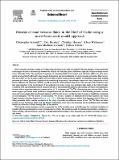Por favor, use este identificador para citar o enlazar a este item:
http://hdl.handle.net/10261/172924COMPARTIR / EXPORTAR:
 SHARE SHARE
 CORE
BASE CORE
BASE
|
|
| Visualizar otros formatos: MARC | Dublin Core | RDF | ORE | MODS | METS | DIDL | DATACITE | |

| Título: | Genesis of mud volcano fluids in the Gulf of Cadiz using a novel basin-scale model approach |
Autor: | Schmidt, Christopher; Burwicz, Ewa; Hensen, C.; Wallmann, K.; Martínez-Loriente, S. CSIC ORCID ; Gràcia, Eulàlia CSIC ORCID | Palabras clave: | Mud volcanism Reactive Transport Modeling Clay dehydration Carbonate recrystallization Fluid flow Gulf of Cadiz |
Fecha de publicación: | dic-2018 | Editor: | Meteoritical Society | Citación: | Geochimica et Cosmochimica Acta 243: 186-204 (2018) | Resumen: | Mud Volcanism and fluid seepage are widespread phenomena in the Gulf of Cadiz (SW Iberian Margin). In this seismically active region located at the boundary between the African and Eurasian plates, fluid flow is typically focused on deeply rooted active strike-slip faults. The geochemical signature of emanating fluids from various mud volcanoes (MVs) has been interpreted as being largely affected by clay mineral dehydration and recrystallization of Upper Jurassic carbonates. Here we present the results of a novel, fully-coupled 1D basin-scale reactive-transport model capable of simulating major fluid forming processes and related geochemical signatures by considering the growth of the sediment column over time, compaction of sediments, diffusion and advection of fluids, as well as convective and conductive heat flow. The outcome of the model is a realistic approximation to the development of the sediment pore water system over geological time scales in the Gulf of Cadiz. Combined with a geochemical reaction transport model for clay mineral dehydration and calcium carbonate recrystallization, we were able to reproduce measured concentrations of Cl, strontium and 87Sr/86Sr of emanating mud volcano fluids. These results support previously made qualitative interpretations and add further constraints on fluid forming processes, reaction rates and source depths. The geochemical signature at Porto MV posed a specific problem, because of insufficient constraints on non-radiogenic 87Sr/86Sr sources at this location. We favour a scenario of basement-derived fluid injection into basal Upper Jurassic carbonate deposits (Hensen et al., 2015). Although the mechanism behind such basement-derived flow, e.g. along permeable faults, remains speculative at this stage, it provides an additional source of low 87Sr/86Sr fluids and offers an idea on how formation water from the deepest sedimentary strata above the basement can be mobilized and eventually initiate the advection of fluids feeding MVs at the seafloor. The dynamic reactive-transport model presented in this study provides a new tool addressing the combined simulation of complex physical-geochemical processes in sedimentary systems. The model can easily be extended and applied to similar geological settings, and thus help us to provide a fundamental understanding of fluid dynamics and element recycling in sedimentary basins | Descripción: | 19 pages, 13 figures, 3 tables, 2 appendices | Versión del editor: | https://doi.org/10.1016/j.gca.2018.09.011 | URI: | http://hdl.handle.net/10261/172924 | DOI: | 10.1016/j.gca.2018.09.011 | Identificadores: | doi: 10.1016/j.gca.2018.09.011 issn: 0016-7037 |
| Aparece en las colecciones: | (ICM) Artículos |
Ficheros en este ítem:
| Fichero | Descripción | Tamaño | Formato | |
|---|---|---|---|---|
| Schmidt_et_al_2018.pdf | 1,17 MB | Adobe PDF |  Visualizar/Abrir |
CORE Recommender
SCOPUSTM
Citations
8
checked on 12-abr-2024
WEB OF SCIENCETM
Citations
8
checked on 20-feb-2024
Page view(s)
268
checked on 18-abr-2024
Download(s)
228
checked on 18-abr-2024
Google ScholarTM
Check
Altmetric
Altmetric
Este item está licenciado bajo una Licencia Creative Commons

